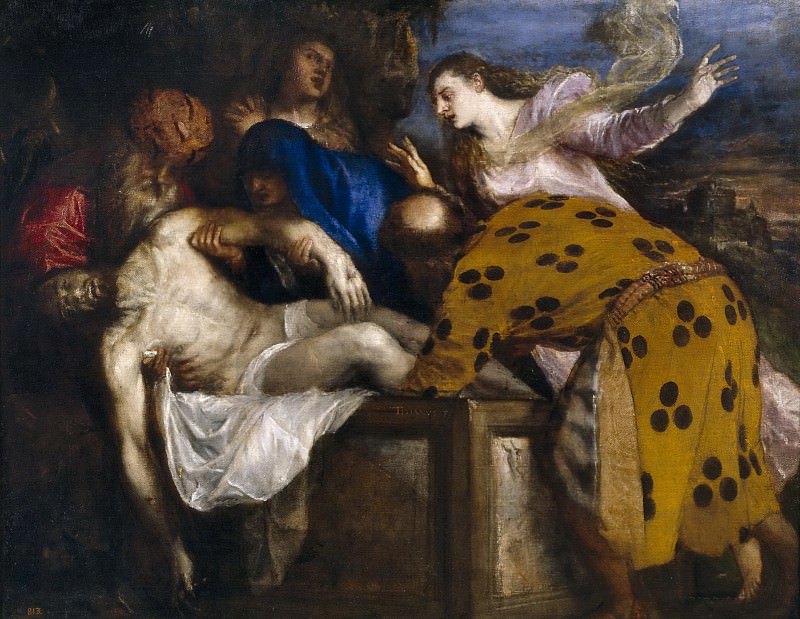Tiziano, Vecellio di Gregorio – Entierro de Cristo Part 1 Prado museum
Part 1 Prado museum – Tiziano, Vecellio di Gregorio -- Entierro de Cristo
Edit attribution
Download full size: 2959×2286 px (2,3 Mb)
Back to album: Part 1 Prado museum
The painting "The Position in the Coffin" was painted by Titian in 1559. The painting measures 148 by 205 cm and was painted on canvas and oil. At the time of the painting Titian had a great interest in the themes of complex, dramatic, which was largely caused by the events taking place at that time in Venice. The struggle in reality is reflected in his painting, the artist’s paintings are full of tension and sorrow. The painting depicts 6 figures, the central figure, as it is not difficult to guess - Jesus Christ.
Description of Titian Vechellio’s painting The Posing of the Coffin
The painting "The Position in the Coffin" was painted by Titian in 1559. The painting measures 148 by 205 cm and was painted on canvas and oil.
At the time of the painting Titian had a great interest in the themes of complex, dramatic, which was largely caused by the events taking place at that time in Venice. The struggle in reality is reflected in his painting, the artist’s paintings are full of tension and sorrow.
The painting depicts 6 figures, the central figure, as it is not difficult to guess - Jesus Christ. Titian depicts him not as skinny, as is more common, but as a muscular man, which gives a sense of strength and ability to fight. Christ appears as a warrior rather than a victim, the victor of a dangerous battle rather than a fragile religious sufferer.
The human figures occupy virtually the entire surface of the canvas, the background is not clearly painted, and a considerable space is also allotted to the coffin, on which, incidentally, the artist places his own signature. The painting is quite vivid. There are several large spots of saturated colors: red, yellow, blue. Christ is traditionally portrayed in white, representing purity and light.
Although, according to the biblical story, Jesus is placed in the coffin in full confidence that he is already dead, the picture does not express grief. Lots of white helps keep the viewers hoping for the best, for a miracle, for a resurrection. The characters in the painting look at Christ with hope, grasping his hands, as if unwilling to let him go to the other world.
The background is not sufficiently detailed, but we can see both the thick clouds and the light breaking through them. Titian skillfully combines the moods of the characters and the moods of nature, this connection is evident. We understand that not only the figures of the characters and their emotions are subject to movement, but that the changing nature is also subject to the same movement.
Кому понравилось
Пожалуйста, подождите
На эту операцию может потребоваться несколько секунд.
Информация появится в новом окне,
если открытие новых окон не запрещено в настройках вашего браузера.
You need to login
Для работы с коллекциями – пожалуйста, войдите в аккаунт (open in new window).




















You cannot comment Why?
A man dressed in blue robes stands slightly apart from the group, his hands raised as if in prayer or supplication. He seems to embody a sense of restrained anguish, contrasting with the more overt displays of grief surrounding him. To the right, a woman in a yellow and brown patterned garment leans forward, her hand resting on the stone slab near the deceased figure’s head. Her posture suggests both mourning and perhaps a gesture of reverence or farewell.
An angel appears at the upper right corner of the scene, its wings partially visible against a darkening sky. The angels outstretched arm seems to offer solace or guidance, suggesting a spiritual dimension to the event unfolding below. A distant cityscape is faintly discernible in the background, adding depth and context to the narrative.
The artist’s use of light and shadow creates a dramatic effect, highlighting key figures and emphasizing the emotional intensity of the scene. The palette is dominated by muted tones – browns, blues, reds, and whites – which contribute to the overall atmosphere of mourning and solemnity. The brushwork appears loose and expressive, lending a sense of immediacy and raw emotion to the depiction.
Subtly, theres an interplay between human grief and divine presence. The angel’s inclusion suggests not only sorrow but also hope and spiritual comfort in the face of loss. The varied expressions and postures of the figures suggest a range of responses to death – from overt weeping to quiet contemplation, from despair to acceptance. The distant cityscape hints at the continuity of life beyond this moment of mourning, implying that even amidst profound grief, existence continues.